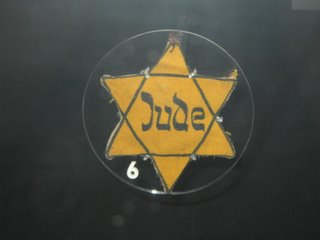Being a student of history, particularly that of a military nature, it was only natural that I would find myself drawn, inevitably, along the District and Bakerloo tube lines to Lambeth North Station and the Imperial War Museum located nearby. Purportedly one of the greatest museums in the world for those who enjoy spending a day gazing at armaments and whatnot, on initial inspection it didn't disappoint. Upon entering through the large gates, one is greeted by the sight of 2 enormous 15 inch naval guns, taken from the battleships HMS Ramillies and HMS Resolution, which served in both World Wars.
However, once you get inside, it was a little disappointing. Only a little, mind you, but still. For one thing, it's far too small. A country with a military history as lengthy and distinguished deserves far more than what's on offer. For starters, only the military history from World War One onwards is covered. Now, for a country that has a record of military events stretching back to the Dark Ages and Alfred the Great, to start 1000 years on from that seems a little presumptuous. What they have on World Wars One and Two is excellent of course, but I was expecting a bit more. However, they also cover a lot of other areas that were very interesting, such as the Cold War, Espionage, the Holocaust and the ongoing nature of warfare in the 21st Century. There's some excellent exhibits and footage relating to MI5, MI6 and the SAS. Any terrorist who watched the video I saw, of the SAS storming the Iranian embassy in London in 1980 would definitely think twice about committing an act of terrorism within range of their long arm.
For a museum that professes itself to be British, there was a surprising amount of Nazi paraphenalia as well. I assume they want to show it off, as a sort of war trophies, but I saw at least 10 Swastikas floating around the place, and not one Union Jack. Which seems kind of odd. Maybe they do it to piss off the German tourists. Anyways, that aside, it was very enjoyable and well worth going to for an afternoon. Of course, we also have pictures.

This is the front of the building. Note the aforementioned battleship armament sited out the front.

We'll start with the British stuff first - this is a Matilda Battle Tank. This was designed in the 1930's, when the tank was still conceived by military tacticians as a vehicle intended to support the infantry, rather than a decisive instrument of war in its own right. Although the theories of blitzkrieg made it somewhat obsolete, it provided excellent service in the North African campaign until 1942, when it was withdrawn from frontline service.

Another desert vehicle, this one being a Daimler Armoured Car, belonging to the famed 7th Armoured Division, the Desert Rats (note the badge depicting the rat).

This imposing looking brute is a Churchill Battle Tank, the mainstay of the British armed forces from 1944 onwards. Unlike the Sherman, this had sufficient armour to repel the standard German 75mm round that the bulk of their Panzers were equipped with, although it was never proof against the dreaded 88mm anti-tank round. It proved an extremely versatile vehicle, with some variations including "Crocodiles" - equipped with flamethrowers, as well as "Flail Tanks" - equipped with a number of revolving chains on a metal bar some metres in front of the tank, designed to clear minefields.

This 1000cc motorcycle was made in 1935, and would be completely unknown except for the fact that T.E Lawrence, better known as "Lawrence of Arabia" was riding it when he had the accident that killed him. The bike only suffered minor damage and was repaired before eventually ending up in the museum.

Anyone who has ever heard of the British field marshal Sir Bernard Law Montgomery - "Monty" - will know of his penchant for always wearing a beret with 2 badges. This is it. They actually had a whole section of the museum dedicated to Montgomery, "Master of Battle", which was very interesting indeed.

Moving on from the British side of things, we come to Russkies - this is the famous T34, the legendary Russian tank that was the mainstay of the Russian army during World War 2. It was so good that the Germans based their Panther Tank on it's design - although they never admitted doing so.

Standard Irish propaganda. Found this in the section relating to the various actions fought in Northern Ireland over the years. I love the dedication shown in persisting with a centuries old argument.

I'm sure we all know what this is.

Now, for some of the German stuff - and there was a lot of it too! Some of it pretty high quality stuff. This was one of the original printed copies of Mein Kampf, dating from the 1920's - the wooden box designed to hold the book was presented to Reinhard Heydrich, one of Himmler's chief subordinates on his birthday from Hitler himself.

Various Nazi uniforms on display. You have to give them one thing - they knew how to make themselves look like a scary bunch of bastards.

A famous painting of Hitler, with one of Goering's summer unifroms in front of it.

The infamous "88" - the 8.8mm Anti-Aircraft gun. Originally designed as an AA Gun, the Germans soon realised it was equally effective when used as an Anti-Tank weapon. The gun found itself employed as the example shown, an anti-aircraft weapon, as well as a towed anti-tank gun, and was also mounted on various Tiger tanks as the primary weapon.

This is an example of one here. This fearsome looking beast is a JagdPanther - based on the chassis of the Panther tank, but packing heavier armour, and equipped with the 88mm gun, as opposed to the standard Panther which had the 75mm gun. This was an anti-tank vehicle through and through - there are many stories of these tanks knocking out several Allied tanks for no loss. Generally the Allies would either attack them using 3 tanks and expect to lose 2, or destroy them from the air with rocket firing RAF Typhoons.
And finally, just so you have an idea of where I'm living at the moment...

This is our street. The backpacker's we're staying is just past the big tree on the left.

















